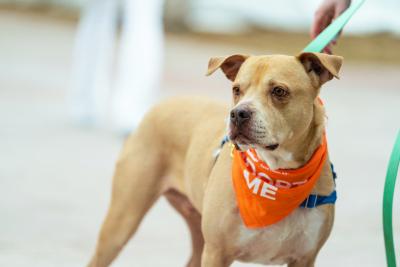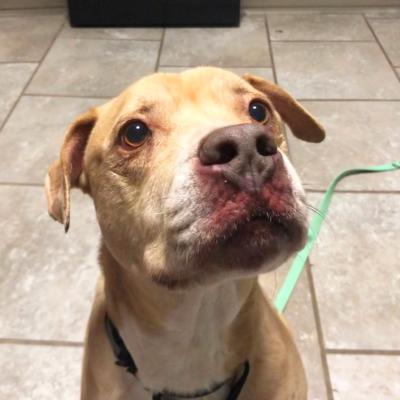Finding an 80-pound senior dog’s happy place

At 80 pounds and reactive to other dogs, Milo might have looked a little scary if you didn’t know him. The 8-year-old dog might have seemed set in his ways — a dog who would have to be kept away from other dogs, which would make it harder to place him in a home. But when Best Friends staff member Madison Bigelow first saw his picture on the online foster board, she noticed a familiar expression in his eyes — the same expression she used to see in the eyes of her childhood dog Oli.
When Madison first laid eyes on wild, 1-year-old Oli at a shelter, he winked at her, and she thought he was magical. Over the years, he matured into a reserved dog whose eyes seemed to say, “OK. I’ve seen it before. Whatever.” That “whatever” look was the one Madison recognized immediately in Milo. It wasn’t the look of a dog who was unfriendly. It was the look of a dog who knew what he was about. And she knew she should foster him.
At the Best Friends Pet Resource Center in Northwest Arkansas, Madison and the staff spent time with Milo to observe firsthand how he would respond to other dogs. They saw that he was friendly but that he had a threshold. When he was overstimulated, his stiff posture and whale eye signaled it.
It was clear when Milo began to feel overwhelmed, and that helped Madison feel more confident about bringing him home. She’d know when to remove him or another dog from the situation to avert trouble. Still, she was nervous about introducing Milo to her dog, Lola, and to her three cats.

Patience, training help older dog overcome barriers
Madison introduced the pets slowly and carefully. First, she had Milo do a parallel walk with Lola, a tried-and-true method for helping a dog manage and overcome the stress of meeting another dog. During a parallel walk, each dog is walked on leash side by side but spaced about 10 to 20 feet apart.
When it seemed both dogs were comfortable and relaxed on their walk, they were allowed to get closer and then interact (still on leash). When it was clear they were comfortable with that step, they were allowed to interact while dragging leashes. Then Madison brought them into the house together.
Though the introduction was a success, Madison didn’t want to move too quickly, knowing that Milo would likely need time to adjust. She and her boyfriend kept the dogs separate in the house.
They introduced Milo to the cats one at a time — first to 18-pound Earl and then to Tiny and Amari, both only 7 pounds. After some initial interest, Milo’s response was mostly “whatever.” Overall, it was a good start — one that would prove memorable and not just because of Milo’s behavior.
[8 reasons to adopt a senior pet]
Milo arrived at Madison and her boyfriend’s house three days before a secretly planned wedding proposal. The night Madison’s boyfriend took her out to pop the question, both he and Madison were completely united in thinking about one thing: Milo. Though they worried he wouldn’t do well with the stress of them being out that night, he was fine. (And she said yes!)
They tried to teach Milo some tricks, but he didn’t seem to care about those. He did, however, get very good at the cue “leave it.” And the more he understood boundaries, the more he relaxed and his playful, friendly, calm (if curmudgeonly) personality stood out.
After three months, Milo had adapted well to life with Madison and her fiancé. He was able to be loose in the same parts of the house as Lola and the cats (though this was always supervised). And that’s when Amber Pierce saw his picture on Facebook.

Older dog blossoms in new home
Amber was looking for a dog who was playful but would be calm and well-mannered in the house while she worked from home. Milo looked so cute and sounded like just that kind of dog.
It was Easter Sunday, and though Amber was sure the pet resource center would be closed, she kept thinking about Milo. She couldn’t shake the feeling that she should just go there. So she went. To her surprise, the center was open, and Milo was there. Instantly, she saw Milo’s sweet, calm temperament mixed with his endearing “OK, whatever” attitude.
It took Amber approximately seven minutes to know — beyond the shadow of a doubt — that Milo was the dog for her. She had had big dogs before, and Madison explained to her how Milo wasn’t always comfortable around other dogs. She did hesitate at the thought that many of the things she hoped to share with a dog — going on hikes or to the dog park — might not be possible with Milo. But then she thought, "Why not give him a chance to try these things?”
[Senior dog is thriving with 2 octogenarians]
It turned out that Milo could visit the dog park, go on hikes, and be around her friend’s dog (and become good friends with that dog). Amber learned that she couldn’t have Milo around other dogs if toys were present. And that’s how it went, with the two of them learning about and adjusting to one another. As Milo’s personality emerged, it painted a slightly different picture from what she first expected.
For example, Amber thought he would be more of a couch potato. But Milo is quite playful and enjoys amusing himself with toys. He spends his days relaxing while Amber works, going for frequent walks, and digging his favorite green squeaky ball out of his toy basket. He enjoys getting it stuck beneath the couch for Amber to retrieve.
“Milo’s a character,” Amber says. “He’s very funny, and I think he knows that.” He prances with his toys in his mouth, cracking Amber up because he’s so large and the movement is so delicate and goofy.
Milo doesn’t do tricks in the traditional sense; he creates his own. Amber and her boyfriend continue to use “leave it” to help Milo understand boundaries, and they do things to help manage his reactivity to other dogs. He is set in some of his ways — like avoiding getting his paws wet by steadfastly refusing to venture out during rain. But that’s just one of the many reasons to love him.






